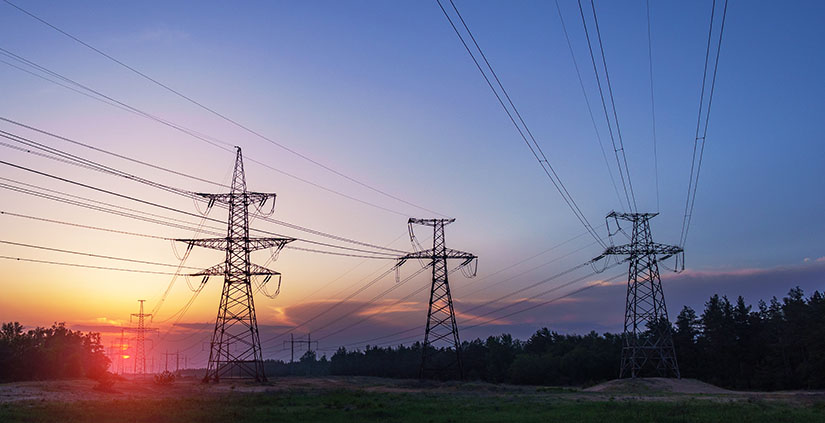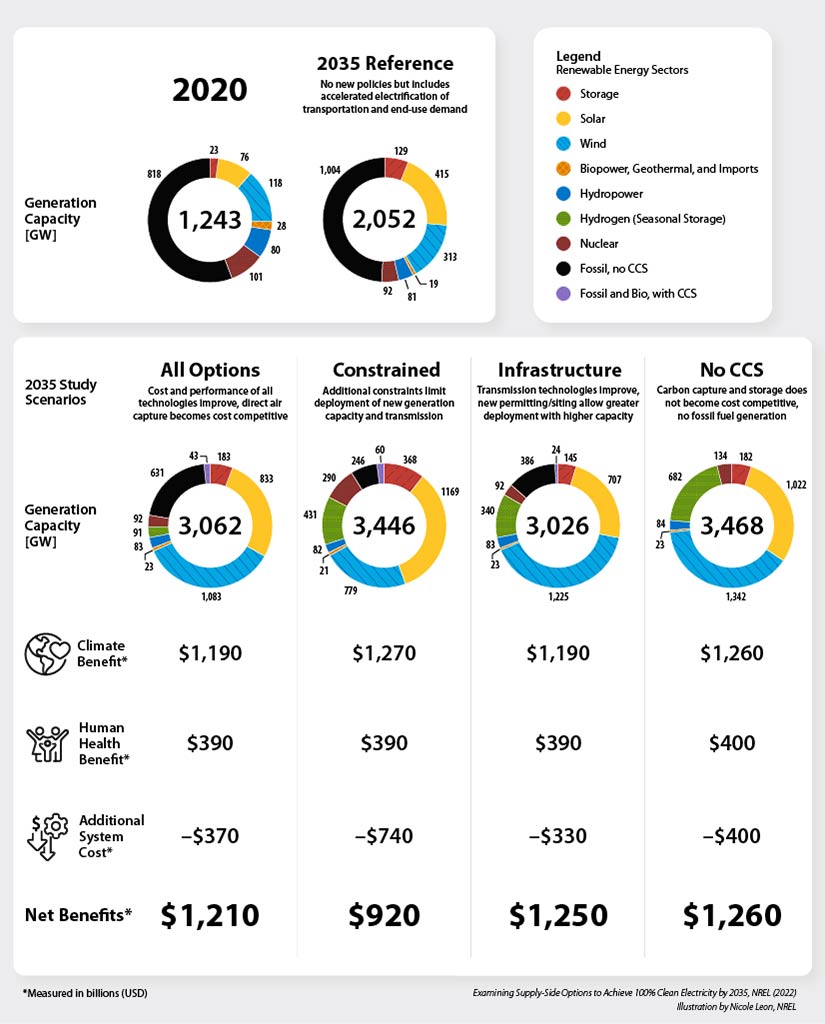100% Clean Electricity by 2035 Study
An NREL study shows there are multiple pathways to 100% clean electricity by 2035 that would produce significant benefits exceeding the additional power system costs.

For the study, funded by the U.S. Department of Energy’s Office of Energy Efficiency and Renewable Energy, NREL modeled technology deployment, costs, benefits, and challenges to decarbonize the U.S. power sector by 2035, evaluating a range of future scenarios to achieve a net-zero power grid by 2035.
The exact technology mix and costs will be determined by research and development, among other factors, over the next decade. The results are published in Examining Supply-Side Options To Achieve 100% Clean Electricity by 2035.
Scenario Approach
To examine what it would take to achieve a net-zero U.S. power grid by 2035, NREL leveraged decades of research on high-renewable power systems, from the Renewable Electricity Futures Study, to the Storage Futures Study, to the Los Angeles 100% Renewable Energy Study, to the Electrification Futures Study, and more.
NREL used its publicly available flagship Regional Energy Deployment System capacity expansion model to study supply-side scenarios representing a range of possible pathways to a net-zero power grid by 2035—from the most to the least optimistic availability and costs of technologies.
The scenarios apply a carbon constraint to:
- Achieve 100% clean electricity by 2035 under accelerated demand electrification
- Reduce economywide, energy-related emissions by 62% in 2035 relative to 2005 levels—a steppingstone to economywide decarbonization by 2050.
For each scenario, NREL modeled the least-cost option to maintain safe and reliable power during all hours of the year.
Key Findings
Technology Deployment Must Rapidly Scale Up
In all modeled scenarios, new clean energy technologies are deployed at an unprecedented scale and rate to achieve 100% clean electricity by 2035. As modeled, wind and solar energy provide 60%–80% of generation in the least-cost electricity mix in 2035, and the overall generation capacity grows to roughly three times the 2020 level by 2035—including a combined 2 terawatts of wind and solar.
To achieve those levels would require rapid and sustained growth in installations of solar and wind generation capacity. If there are challenges with siting and land use to be able to deploy this new generation capacity and associated transmission, nuclear capacity helps make up the difference and more than doubles today’s installed capacity by 2035.
Across the four scenarios, 5–8 gigawatts of new hydropower and 3–5 gigawatts of new geothermal capacity are also deployed by 2035. Diurnal storage (2–12 hours of capacity) also increases across all scenarios, with 120–350 gigawatts deployed by 2035 to ensure demand for electricity is met during all hours of the year.
Seasonal storage becomes important when clean electricity makes up about 80%–95% of generation and there is a multiday to seasonal mismatch of variable renewable supply and demand. Across the scenarios, seasonal capacity in 2035 ranges about 100–680 gigawatts.
Significant additional research is needed to understand the manufacturing and supply chain associated with the unprecedent deployment envisioned in the scenarios.
Significant Additional Transmission Capacity
In all scenarios, significant transmission is also added in many locations, mostly to deliver energy from wind-rich regions to major load centers in the eastern United States. As modeled, the total transmission capacity in 2035 is one to almost three times today’s capacity, which would require between 1,400 and 10,100 miles of new high-capacity lines per year, assuming new construction starts in 2026.
Climate and Health Benefits of Decarbonization Offset the Costs
NREL finds in all modeled scenarios the health and climate benefits associated with fewer emissions offset the power system costs to get to 100% clean electricity.
Decarbonizing the power grid by 2035 could total $330 billion to $740 billion in additional power system costs, depending on restrictions on new transmission and other infrastructure development. However, there is substantial reduction in petroleum use in transportation and natural gas in buildings and industry by 2035. As a result, up to 130,000 premature deaths are avoided by 2035, which could save between $390 billion to $400 billion in avoided mortality costs.
When factoring in the avoided cost of damage from floods, drought, wildfires, and hurricanes due to climate change, the United States could save over an additional $1.2 trillion—totaling an overall net benefit to society ranging from $920 billion to $1.2 trillion.
Necessary Actions To Achieve 100% Clean Electricity
The transition to a 100% clean electricity U.S. power system will require more than reduced technology costs. Several key actions will need to take place in the coming decade:
- Dramatic acceleration of electrification and increased efficiency in demand
- New energy infrastructure installed rapidly throughout the country
- Expanded clean technology manufacturing and the supply chain
- Continued research, development, demonstration, and deployment to bring emerging technologies to the market.
Failing to achieve any of the key actions could increase the difficulty of realizing the scenarios outlined in the study.
Study Resources
Full Report
Download the technical report, Examining Supply-Side Options To Achieve 100% Clean Electricity by 2035.
Supporting Materials
Download the report overview infographic and a 1-slide summary brief deck or a 10-slide summary brief deck.
Contact
Share


